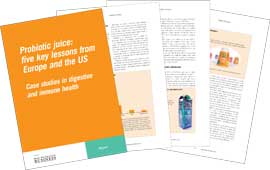Price (PDF or PPT):
US$530 £320 €400 NZ$630 AU$570 ¥550000
20% Discount if PDF and PPT purchased together

Case studies in digestive and immune health. Probiotic juice is one of the biggest untapped innovation opportunities in the healthy beverage business, worldwide. The author of this unique report, Julian Mellentin, drawing on case studies from Europe and the US, sets out the five key lessons that are essential reading for anyone who wants succeed in probiotic juice.
About this report
Probiotic juice is one of the biggest untapped innovation opportunities in the healthy beverage business, worldwide. The author of this unique report, Julian Mellentin, drawing on case studies from Europe and the US, sets out the five key lessons that are essential reading for anyone who wants succeed in probiotic juice.
The prevailing focus of interest in probiotics for digestive and immune health is dairy and solid foods, yet the biggest untapped opportunity lies in juice drinks.
In Europe it’s already a success story. The ProViva probiotic digestive health drink has become a mass-market success in Sweden, where its per capita sales make it equivalent to a $2.1 billion annual sales brand - as big as Gatorade. The brand has even maintained 8% annual growth during a year of economic recession, despite selling at a 50% premium to regular juices.
Boosted by this success, the company behind ProViva has launched new variants that extend probiotic juice into sports and women’s nutrition as well as a new probiotic juice that’s clinically shown to combat the symptoms of cold and flu.
ProViva’s success has inspired a clutch of embryonic brands in other markets, such as the Good Belly brand in the US. Good Belly’s founder, food entrepreneur Steve Demos, is interviewed about his experience with launching a probiotic juice brand – one that has seen him totally change his strategy, just a year after launch.
Underpinning Mellentin’s concise analysis of the success factors are four case studies – all based on interviews with senior executives at the companies concerned - which include:
- supermarket sales data
- repeat purchase rates and market penetration
- strategies to penetrate the early adopter market and grow from there to the mass-market
- which marketing techniques are most effective and why
- communications strategies
- health claims and label messages
- how probiotic products are priced and how some can achieve super-premium prices
- taste trends
- brand extensions and new segments
This report – the only one of its kind on probiotic juice strategy - is written for anyone trying to develop an effective strategy in the challenging and fast-changing area of probiotics. It provides executives in marketing, technical, innovation and NPD roles with real-world insights that can be applied in any setting.


